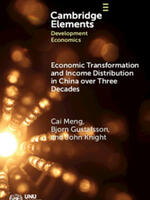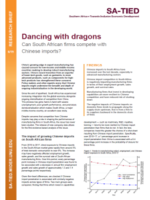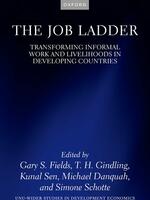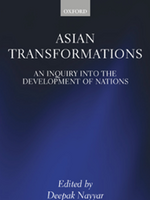Filter by...
Reset all
Publications (404)

It is arguable that the most important event in the world economy in recent decades has been the rise of China, from being on a par with sub-Sahara Africa at the start of economic reform to being an economic superpower today. That rise remains under-researched. Moreover, the great structural changes...
Book Chapter
This peer-reviewed research is available free of charge. UNU-WIDER believes that research is a global public good and supports Open Access.
From the book:
Tasks, Skills, and Institutions
Working Paper
pdf
– Guidelines for NEP implementation
This paper documents the state of elementary education in India and China since the 1960s, key lessons for India from China’s shift in focus from ‘quantity’ to ‘quality’, and evidence-based guidelines for effective implementation of India’s New Education Policy 2020 (NEP 2020). The divergent policy...
Book Chapter
This peer-reviewed research is available free of charge. UNU-WIDER believes that research is a global public good and supports Open Access.
– Structural transformation, inequality, and inclusive growth in China
From the book:
The Developer’s Dilemma
Working Paper
pdf
– Lessons from 19th-century America and 21st-century China
How do modern fiscal states arise? Perhaps the most dominant explanation, based on the European experience, is that democratic institutions that limited the extractive power of states—exemplified by the 1688 Glorious Revolution in England—paved the way for the rise of fiscal capacity and subsequent...

– A case study of social mobility research in the Global South
Part of Journal Special Issue
Social mobility in developing countries
Working Paper
pdf
– A case study of the Eastern Industry Park
Despite the Ethiopian government’s commitment to attracting foreign direct investment to its emerging manufacturing sector and its shared interests with Chinese private businesses in building profitable investments, relations between Chinese private businesses and the Ethiopian government are not...
Working Paper
pdf
This paper examines the evolution of China’s industrial and occupational structure in the last two decades and its impact on wage inequality. We find that non-routine cognitive and interpersonal tasks have increased, while routine cognitive tasks first increased and then declined. Occupation...
Journal Article
This peer-reviewed research is available free of charge. UNU-WIDER believes that research is a global public good and supports Open Access.
– Evidence from the Han and ethnic minorities in China
This study investigates the unexpected impact that enforcing birth control policies in China has upon the educational stratification between the Han majority, the policy target group, and ethnic minorities, a partially excluded group. Exploring county-level variation in the value of fines levied for...
Book Chapter
This peer-reviewed research is available free of charge. UNU-WIDER believes that research is a global public good and supports Open Access.
– Different economic models but similarly low levels of socioeconomic mobility
From the book:
Inequality in the Developing World
Book Chapter
This peer-reviewed research is available free of charge. UNU-WIDER believes that research is a global public good and supports Open Access.
– Structural change, transition, rent-seeking and corruption, and government policy
From the book:
Inequality in the Developing World
Working Paper
pdf
Understanding the relationship between income inequality and economic growth is of utmost importance to economists and social scientists. In this paper we use a Bayesian structural vector autoregression approach to estimate the relationship between inequality and growth via growth and inequality...
Working Paper
pdf
– The case of BRICS
As the world battles with the triple problems of social, economic, and environmental challenges, it has become important to focus both policy and research efforts on these. Therefore, this study examines the effect of wealth inequality on CO2 emissions in five emerging economies: Brazil, Russia...
Working Paper
pdf
The informal sector has long been viewed as a locus of the disadvantaged, unskilled, and inexperienced workers in under-developed and developing economies. Workers in the informal sector, however, can learn skills and gain experience that could help them switch to better-paying jobs in the formal...
Journal Article
This peer-reviewed research is available free of charge. UNU-WIDER believes that research is a global public good and supports Open Access.
Part of Journal Special Issue
Income inequalities and redistribution in China
Journal Article
This peer-reviewed research is available free of charge. UNU-WIDER believes that research is a global public good and supports Open Access.
– Data collection and the impact on income inequality
Part of Journal Special Issue
Income inequalities and redistribution in China
Journal Article
This peer-reviewed research is available free of charge. UNU-WIDER believes that research is a global public good and supports Open Access.
Part of Journal Special Issue
Income inequalities and redistribution in China
Journal Article
This peer-reviewed research is available free of charge. UNU-WIDER believes that research is a global public good and supports Open Access.
– A comparative approach with India
Part of Journal Special Issue
Income inequalities and redistribution in China
Journal Article
This peer-reviewed research is available free of charge. UNU-WIDER believes that research is a global public good and supports Open Access.
– 1988-2013
Part of Journal Special Issue
Income inequalities and redistribution in China
Journal Special Issue
This peer-reviewed research is available free of charge. UNU-WIDER believes that research is a global public good and supports Open Access.
This special section presents the main findings about long-run trends in inequality in China and its driving factors as they emerge from a country case study carried out under a UNU-WIDER-supported project. Special focus in the umbrella project were on three issues: (i) the role of earnings...
Journal Article
This peer-reviewed research is available free of charge. UNU-WIDER believes that research is a global public good and supports Open Access.
Part of Journal Special Issue
Income inequalities and redistribution in China
Working Paper
pdf
– What’s China got to do with it?
The term fiscal resource curse refers to countries’ inability to raise taxes from a broad base in the presence of natural resources. We employ a novel instrumental variable strategy to estimate the causal effect of resource revenues on non-resource tax effort by exploiting the so-called ‘China shock...
Working Paper
pdf
In this paper, we analyse the relationship between China’s structural transformation and the inclusiveness of its economic growth. China’s economy has undergone significant structural changes since it initiated the economic reforms in 1978. Economic activities have shifted from the low-productivity...
Working Paper
pdf
– A case study of a quantitative sociological approach to social mobility research in the Global South
This study analyses intergenerational class mobility in China as a case study of a quantitative sociological approach to social mobility research in the Global South. Drawing on national representative surveys collected between 2010 and 2015 in China, the analysis focuses on absolute and relative...
Journal Article
This peer-reviewed research is available free of charge. UNU-WIDER believes that research is a global public good and supports Open Access.
Part of Journal Special Issue
Welfare and distributive effects of social assistance in the Global South
Working Paper
pdf
– Different economic models but similarly low levels of socioeconomic mobility
The United States and China are the world’s largest economies. Together they are responsible for about one-third of the world’s economic output. This paper aims to examine whether the two economic giants are also lands of opportunity where resources are allocated in a way that minimizes unrealized...

– Can South African firms compete with Chinese imports?
China’s growing edge in export manufacturing has caused concern for low-income and middle-income countries seeking to develop robust manufacturing sectors. China’s recent transition from an exporter of lower-tech goods, such as garments, to more advanced products, such as components for high-tech...
Working Paper
pdf
– Chinese import penetration and the performances of manufacturing firms in South Africa
Using firm-level tax administrative data from 2010 to 2017, we study the impact of Chinese import penetration on the performances of manufacturing firms in South Africa, and whether firms investing in capabilities development are more resilient to such competitive pressure. Specifically, by...
Journal Special Issue
This peer-reviewed research is available free of charge. UNU-WIDER believes that research is a global public good and supports Open Access.
Building knowledge about migration governance and policy in the Global South is a priority for research and policy. The studies in this special section offer both new empirical insights and new frameworks for analysis, with key policy implications, that can enrich our discussion of these topics...
Journal Article
This peer-reviewed research is available free of charge. UNU-WIDER believes that research is a global public good and supports Open Access.
– The Impacts of China's Informal Gold Rush in Ghana
Part of Journal Special Issue
Migration Governance and Policy in the Global South
Displaying 32 of 404 results
 Join the network
Join the network
